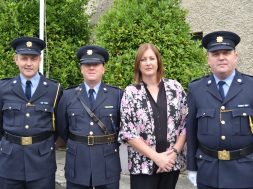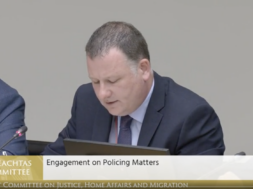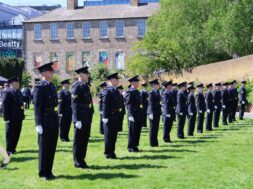
AGSI attended the official opening of the new Kevin Street Garda Station and visited a number of our members based there. Below are photos by Alan Dowley and the official Government press statement.
PRESS RELEASE
Justice Minister, Charlie Flanagan officially opens new Garda Headquarters of the Dublin Metropolitan Region (DMR) & South Central Division at Kevin Street
30 August 2018
The Minister for Justice and Equality, Charlie Flanagan TD, has today, alongside Acting Garda Commissioner Donall Ó Cualáin, opened the new Kevin Street Garda Station, Dublin Metropolitan Region (DMR) South Central Divisional Headquarters, in an event attended by Minister of State at the Office of Public Works Kevin “Boxer” Moran and representatives from the local area including community and civil society groups and members of An Garda Síochána.
Kevin Street Garda Station is one of three major new Garda Regional and Divisional Headquarters recently completed. An Garda Síochána indicate that approximately 220 persons including both Garda and Civilian personnel will be based in this station.
The other two major new completed Garda HQ developments are at Wexford (September 2017), and at Galway (July 2018). The construction of these three regional and divisional headquarters involved Exchequer funding of over €100 million.
These state-of-the-art facilities represent a major investment in Garda infrastructure and will significantly assist An Garda Síochána both in continuing to provide a professional policing service in their regions and in the delivery of the Modernisation and Renewal Programme.
Speaking at the opening, Minister Flanagan referred to the symbolism of the new state of the art building and its importance in the Garda estate, saying: “The contemporary building design reflects the public face of the Gardaí as a modern police service and represents a new phase in the relationship between the Gardaí and the city. Approximately 140 Garda members and civilian staff are already based here in Kevin Street with another 80 or so additional staff to arrive in late September including newly promoted Sergeants, Inspectors, and Garda and Civilian staff for the Divisional Policing Model (DPM) staff and Scenes of Crime Personnel.”
The Minister also referred to the Government’s ongoing investment in the Garda estate, saying: “We are now seeing the results of the unprecedented public funding provided to An Garda Síochána in recent years. In addition to the 3 top-quality regional and divisional headquarters completed in Galway, Wexford and Dublin, significant progress is now also being made by the Office of Public Works, in conjunction with An Garda Síochána, in the wider Garda Building and Refurbishment Programme. For example, cell upgrade works have already been completed at 80 Garda stations”.
Minister Flanagan noted that the opening of the new DMR South Central Headquarters at Kevin Street was taking place at a time of major reform and investment, which will redefine our national police service as an organisation. He said “As we approach the centenary of the establishment of An Garda Síochána, we are in fact about to turn the page to a new phase for this fine organisation. The appointment of a new Commissioner, and one who comes from a different police service, albeit one that works closely with the Gardaí, is significant and I hope will enrich the organisation. The impending completion of the work of the Commission on the Future of Policing in Ireland, will chart a new model for Irish policing in the decades ahead and will challenge us all to deliver a new vision for policing in Ireland.”
Minister Flanagan outlined the progress in implementing the Government’s plan to introduce an overall workforce of 21,000 by 2021 comprised of 15,000 Gardaí, 4,000 civilians and 2,000 Reserves. Almost 2,000 recruits have attested as members of An Garda Síochána and have been assigned to mainstream duties nationwide since the reopening of the Garda College in September 2014. This investment resulted in a net increase of over 600 Gardaí last year. This year a further 800 new Garda recruits will enter the Garda College and the strength of the Service will reach 14,000 by the end of the year.
The Minister emphasised his commitment to the civilianisation programme and highlighted the importance of the Garda Reserve saying: “As Minister for Justice and Equality, I am particularly committed to the civilianisation programme which aims to ensure that administrative functions are carried out by skilled professional civilians to in turn free up sworn members to deploy their training, expertise and experience to what they do best – policing our communities. Over 290 new civilian staff have been sanctioned in the last 18 months and so far over 110 Gardaí have been redeployed to policing. This is a welcome start but there is a lot more work to be done to fully realise our ambitious plans. I know the Commissioner has a dedicated project team in place to drive the redeployment programme while ensuring that it is done in a manner that is fair to all. And I very much welcome that. There are also plans to strengthen the Garda Reserve with new reserves expected to start training this year.”
Minister Flanagan also took the opportunity to thank Acting Commissioner Ó Cualáin for his service, in advance of his imminent retirement, thanking him “for the many years of dedicated service you have given to the public and the State and for the steady and effective leadership shown in most challenging times”. Addressing Acting Commissioner Ó Cualáin, Minister Flanagan stated: “You and your team have led An Garda Síochána to significant successes in targeting and disrupting the abhorrent activities of criminal gangs over the past year. You have also made progress on the challenging reform agenda, and this weekend, as you pass on the baton to incoming Commissioner Drew Harris, we wish you a happy and well-deserved retirement and many happy years with your family and friends.”
ENDS
Notes for editors
The Office of Public Works (OPW) Architectural Services team led by State Architect Ciaran O’Connor designed the new DMR South Central Headquarters at Kevin Street.
The building has an overall area of 12,240 square metres, consisting of five storeys over a two level basement. It fulfils other much needed modern standards of major operational facilities for the Gardaí within the city. The new building will provide:
· Infrastructure for Gardaí training and development with state-of-art facilities
· Prisoner 24/7 detention facility
· Archive quality PEMS evidence store
· Major Incident Rooms
· Other specialist facilities
· Public office
The contemporary building design reflects the public face of the Gardaí as a modern police force and represents a new modern phase in the relationship between the Gardaí and the city. It is designed as a civic quality building responding to the specific site context of its historic surroundings. The building is energy efficient and sustainable with universal access for all.
It will provide fit for purpose twenty first century facilities replacing the out of date and inefficient facilities and will mark a big step forward in the qualities of operational facilities for the Gardaí in Dublin City.
The building is arranged in linear blocks of accommodation either side of an atrium space. It reinstates the street line along Bride Street with a five-storey building opposite the seven-storey National Archive building. The five-storey curved block steps down in a series of steps to become two storey adjacent to the existing Garda station, the former medieval Archbishops Palace, thereby responding in scale to these important historic buildings.
The important Kevin Street junction is acknowledged by expressing the central atrium space on that façade. The public entrance is located at this point. The atrium serves as the main vertical and horizontal circulation space within the building. It also provides for natural ventilation to all offices along with natural air extraction and allows daylight to penetrate into the building.
The OPW was responsible for the Architectural, Project Management and Fire and Security elements of the project, with Civil and Structural consultants Atkins, and Mechanical and Electrical consultants Varming. The main contractor was J.J. Rhatigan & Company.
CHECK AGAINST DELIVERY
Address by Minister Charlie Flanagan, T.D., Minister for Justice and Equality at the official opening of Kevin Street Garda Station
DMR South Central Divisional Headquarters
30 August 2018 at 10am
Commissioner
Distinguished guests
Serving and retired members of An Garda Síochána
Civil society and community representatives
Ladies and Gentlemen
I am delighted to be here with you today on what is a very important occasion for Kevin Street, its environs and for the community of south inner city Dublin.
This is my third official opening of a Garda Divisional Headquarters this year, having opened the Western Region Garda Headquarters in Galway in July and Wexford Divisional Headquarters on the first of August. These new headquarters are perhaps the most tangible evidence of this Government’s ongoing investment in An Garda Síochána and the importance we attach to policing.
I am pleased to be joined again by Commissioner Donall Ó Cualáin at this ceremony. Commissioner Ó Cualáin, as your tenure as acting Commissioner draws to a close in a few short days, I want today, to again acknowledge and publicly thank you, for the many years of dedicated service you have given to the public and the State. I and my colleagues in Government are grateful to you for the steady and effective leadership you have shown in most challenging times. You and your team have led An Garda Síochána to significant successes in targeting and disrupting the abhorrent activities of criminal gangs over the past year. You have also made progress on the challenging reform agenda, and this weekend, as you pass on the baton to incoming Commissioner Drew Harris, we wish you a happy and well-deserved retirement and many happy years with your family and friends.
Looking ahead though, there is no question but that the incoming Commissioner is taking up office at a pivotal time in the history of An Garda Síochána. It is perhaps an understatement to say that this is a time of major reform and investment. As we approach the centenary of the establishment of An Garda Síochána, we are in fact about to turn the page to a new phase for this fine organisation. The appointment of a new Commissioner, and one who comes from a different police service, albeit one that works closely with the Gardaí, is significant and I hope will enrich the organisation. The impending completion of the work of the Commission on the Future of Policing in Ireland, will chart a new model for Irish policing in the decades ahead and will challenge us all to deliver a new vision for policing in Ireland.
And while change can be challenging, daunting even, it undoubtedly presents opportunities … opportunities to do things differently, to do things better, to reinvigorate an organisation and harness the many talents and energy of its people.
In terms of investment, it is the people that make any organisation. And when I refer to the people in this organisation I am, of course, referring to the full spectrum of the Garda workforce – Gardaí, civilian staff and Reserve members. The best modern police services are those with an integrated workforce, where policing professionals and civilian staff work hand in hand, where their respective skills and expertise are equally recognised and valued, and which harness the energy and enthusiasm of local volunteers.
This is the vision that the Government has for An Garda Síochána, a vision of an overall workforce of 21,000 by 2021 comprised of 15,000 Gardaí, 4,000 civilians and 2,000 Reserves.
In support of this vision, almost 2,000 recruits have attested as members of An Garda Síochána and have been assigned to mainstream duties nationwide since the reopening of the Garda College in September 2014. This investment resulted in a net increase of over 600 Gardaí last year. This year a further 800 new Garda recruits will enter the Garda College and the strength of the Service will reach 14,000 by the end of the year.
As Minister for Justice and Equality, I am particularly committed to the civilianisation programme which aims to ensure that administrative functions are carried out by skilled professional civilians to in turn free up sworn members to deploy their training, expertise and experience to what they do best – policing our communities.
Over 290 new civilian staff have been sanctioned in the last 18 months. and so far over 110 Gardaí have been redeployed to policing. This is a welcome start but there is a lot more work to be done to fully realise our ambitious plans. I know the Commissioner has a dedicated project team in place to drive the redeployment programme while ensuring that it is done in a manner that is fair to all. And I very much welcome that.
There are also plans to strengthen the Garda Reserve with new reserves expected to start training this year.
The Reserve has an important role to play in providing a police service to our communities. Increasingly, it also provides an introduction to policing to those who are considering it as a career. A reserve of 2,000 committed volunteers, together with the 4,000 civilians planned, will be of huge assistance to An Garda Síochána in delivering a 21st century policing service and it is important to the public who time and time again reiterate their desire for a greater measure of reassuring visible patrols in their communities. I want to see progress towards those ambitious numbers accelerated over the coming months so that by 2021, we have achieved our targets.
Moving now from people to the tools they need … As we all know, achieving 21st century policing requires modern technology and facilities. My Department and I are working very hard to support and achieve this goal, across the board – in terms of the Garda estate, fleet and ICT.
Unprecedented resources have been made available in recent years to address the real deficiencies in the Garda estate and provide fit-for-purpose facilities for members and the public interacting with them.
It inevitably takes some time to see the results of investment such as this. It can be hard not to be impatient, but the reality is that design, planning and procurement for large projects do take time, if we are going to ensure fairness and the best possible results at the best possible value. However, we are now seeing the results of the unprecedented public funding provided to An Garda Síochána in recent years coming to fruition.
In addition to the three top-quality Divisional Headquarters works have already been completed at 80Garda stations under the Cell Refurbishment Programme. In addition, appropriate sites are now in state ownership allowing us to progress the Public Private Partnership to deliver new stations at Macroom, Sligo and Clonmel. All of this work is part of a five year Building and Refurbishment Programme.
As far as the Garda fleet is concerned, the 2016 – 2021 Capital Plan provides €46 million, in addition to the investment of almost €30 million in the period 2013 to 2015, to ensure An Garda Síochána have a modern, effective and fit-for-purpose fleet. As a result, in the four years from 2013 to 2017, some 2,000 new vehicles came on stream – ensuring that Gardaí can be mobile, visible and responsive on the roads and in the community to prevent and tackle crime.
As a Government, we also recognise that Gardaí must have the technology necessary to detect and investigate crime. And so, in support of the MRP, €342 million, including €217 million under the Capital Plan, is being invested in Garda ICT infrastructure between 2016 and 2021. This will enable An Garda Síochána to work more effectively and deploy the latest cutting-edge technologies in the fight against crime.
My commitment and that of the Government to supporting An Garda Síochána is unwavering. I look forward to continuing to engage with colleagues, particularly in the OPW and Garda management, to deliver on the ambitious reform and investment programmes underway.
Turning back to the reason for today’s ceremony – I am confident the new Kevin Street Garda station and Divisional Headquarters will have a positive and beneficial impact on the south inner city of Dublin.
I understand that An Garda Síochána took up residence in this magnificent building on 14 May 2018. Approximately 140 Garda members and civilian staff are based here in Kevin Street with another 80 or so additional staff to arrive in late September including newly promoted Sergeants, Inspectors, and Garda and Civilian staff for the Divisional Policing Model (DPM) staff and Scenes of Crime Personnel.
The new facility, designed by the Office of Public Works, provides vital, twenty-first century facilities which are fit for purpose and mark a big step forward in terms of the operational facilities for the Gardaí in Dublin City. The building is energy efficient and sustainable with universal access for all.
The contemporary building design reflects the public face of the Gardaí as a modern police service and represents a new phase in the relationship between the Gardaí and the city.
It is designed cognisant of its historic surroundings. The 5 storey curved block steps down to become a 2 storey facility adjacent to the previous Kevin Street Garda station, which I understand is the former medieval Archbishops Palace. It also reinstates the street line along Bride Street with a 5 storey building opposite the 7 storey National Archive building. This design thereby responds in scale to these important historic buildings.
This headquarters includes infrastructure for Gardaí training and development, a 24/7 Prisoner detention facility, a public office and other specialist features.
The OPW was responsible for the Architectural, Project Management and Fire and Security elements of the project, with Civil and Structural consultants Atkins, and Mechanical and Electrical consultants Varming. The main contractor was J.J. Rhatigan & Company.
It’s an impressive project, and it could not have occurred without the input and cooperation of many people and agencies, including:
– An Garda Síochána, in particular the Estates Management team;
– the Office of Public Works – particularly Ciarán O’Connor and his team from the OPW Architectural Service, and the OPW Project management team headed up by Commissioner John Sydenham;
– the Representative Associations; officials in my own Department;
– and absolutely central to the success of the project was the tremendous contribution made by the main contractors, J. J. Rhatigan and Company, in delivering on the project design and providing us with a facility that will serve the Gardaí and residents of Kevin Street well for many years to come.
I thank and commend you all for your dedication and professionalism.
As I see it, every investment in our Garda Síochána is an investment in a community and as such, the opening of a new facility such as this is an event to be celebrated. The wonderful turn-out for this event today – and the breadth of organisations you represent – is testament to that.
It only remains for me to say that I am honoured to declare Kevin Street Garda Station officially open.
Gach rath ar an obair agus go raibh maith agaibh go léir.


















